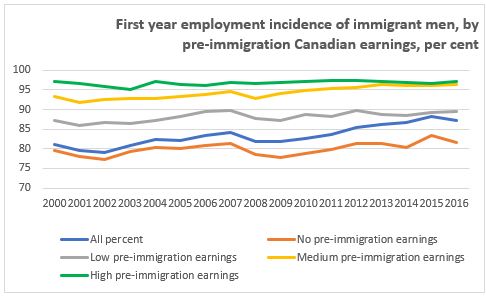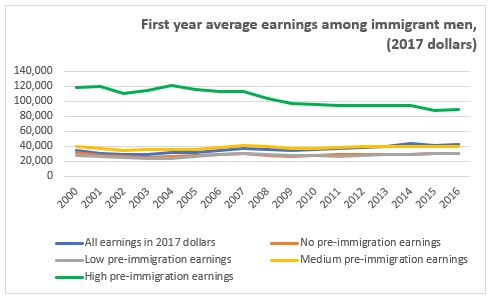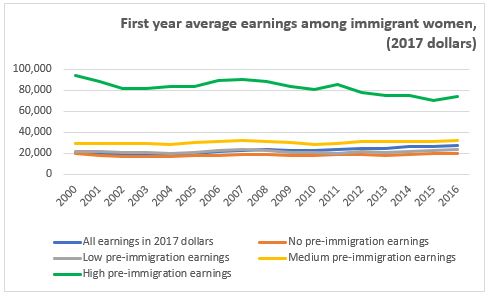The Economics and Statistics Division maintains archives of previous publications for accountability purposes, but makes no updates to keep these documents current with the latest data revisions from Statistics Canada. As a result, information in older documents may not be accurate. Please exercise caution when referring to older documents. For the latest information and historical data, please contact the individual listed to the right.
<--- Return to Archive
For additional information relating to this article, please contact:
July 23, 2020STUDY: INCREASING SELECTION OF IMMIGRANTS FROM AMONG TEMPORARY FOREIGN WORKERS IN CANADA Statistics Canada released a (summary) based on the first three studies of a five-part series that provides a broad overview of the increasing importance of temporary foreign workers in the selection and labour market outcomes of new immigrants in Canada. These studies were conducted in collaboration with Immigration, Refugees and Citizenship Canada (IRCC). COVID-19 has hampered the inflow of immigrants from abroad due to global travel restrictions and the number of people who were granted permanent resident status fell 75 per cent in April and May on a year-over-year basis. Processing of immigration applications has mostly been restricted to temporary foreign workers who are already in Canada. The selection of economic immigrants from among temporary foreign workers has been a growing trend since the early 2000s, and it has had a strong impact on new immigrants' labour market outcomes.
In 2018, 46 per cent of new economic immigrants were former temporary foreign workers compared to only 8 per cent in 2000. The process of selecting economic immigrants from among temporary foreign workers and international students is often referred to as two-step immigration selection. In this process, Canadian employers play a major role in recruiting and evaluating temporary foreign workers, while the government determines how many and which temporary residents are eligible for admission as permanent residents.
The first study synthesizes international and Canadian studies on the pros and cons of two-step immigration selection. Positive aspects of the two-step process include improving the matching between skills and labour market demand as employers have had opportunity to observe workers. Statistics Canada notes that some potential issues associated with dependence on temporary foreign workers have been seen during the COVID-19 pandemic, including uncertainty of labour supply to essential industrial sectors and poor working conditions for some temporary foreign workers.
The second study documents the evolution of two-step immigration selection since the early 2000s. Two-step immigration has increased from only 12 per cent of new economic immigrant principal applicants in 2000 to 59 per cent in 2018. This expansion was driven by the rising number of temporary foreign workers and their increased rate of transition to permanent residency.
The increased transition rate is related to the growth of the Provincial Nominee Program (PNP)and the introduction of the Canadian Experience Class (CEC) which differ with respect to Canadian work experience among applicants. In 2018, 25 per cent of economic immigrant principal applicants were admitted through the Federal Skilled Worker Program (FSWP), while 46 per cent were selected under PNP and 20 per cent were selected through the CEC.
Among principal applicants admitted in 2018, 11 per cent of FSWP immigrants had worked in Canada before immigration, compared with 62 per cent in the provincial programs and 97 per cent in the CEC.
The third study examines the relationship between two-step immigration selection and immigrant labour market outcomes. The study found that "The employment incidence (the percentage of immigrants with positive annual earnings) in the first full year after immigration rose from 81 per cent to 87 per cent from 2000 to 2016 among men aged 20 to 54 years and from 61 per cent to 67 per cent among women. The increase in employment incidence was attributable mostly to the rising share of new immigrants who had worked in Canada before immigration at medium ($20,000 to $50,000 in 2017 dollars) or high (over $50,000) annual earnings levels."


The average earnings of immigrants also rose over time, coinciding with rising two-step immigration shares, with first full-year after immigration increasing 23 per cent for men and 32 per cent for women for the 2016 landing cohort relative to the 2000 landing cohort. The rising share of immigrants with previous Canadian work experience accounted for over 90 per cent of the increase for both men and women.


The key conclusion to the study was, “The expanding use of temporary foreign workers as a pool from which to select permanent residents was more important than any other single factor in accounting for the improvement in immigrant economic outcomes at entry." The 2008-2009 recession had a strong impact on the initial employment levels among economic immigrants without pre-immigration Canadian earnings, but no impact on those with medium or high pre-immigration Canadian earnings.
The earnings and employment differences between two-step and other immigrants declines after five years, but with a gap remaining even after this time. Notably, the immigrants with medium and high pre-landing Canadian earnings maintained higher levels than those without pre-landing Canadian work experience.
Evidence based on immigrants who landed before the mid-2000s shows the earnings advantage of immigrants with pre-immigration Canadian work experience remained 10 years after landing.
Source: Statistics Canada, Study: Increasing selection of immigrants from among temporary foreign workers in Canada
<--- Return to Archive